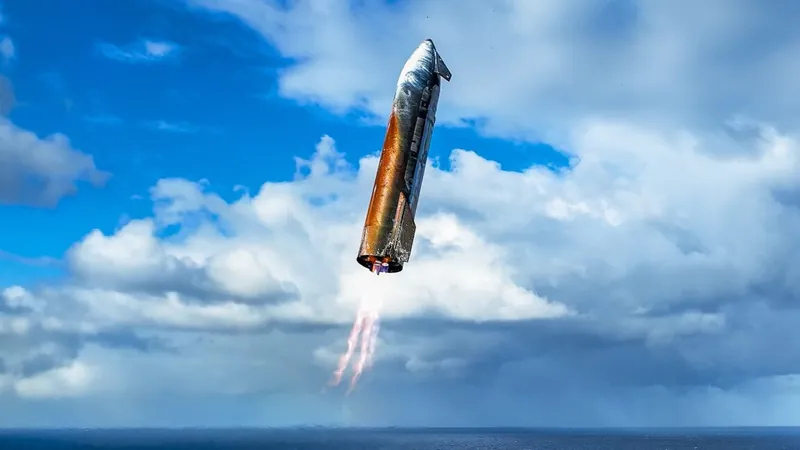
SpaceX's Starship Soars to New Heights: What's Next After Flight 10?
2025-09-09
Author: Ken Lee
Two weeks have passed since SpaceX's exhilarating Starship test flight, and engineers have been hard at work diagnosing heat shield issues and plotting their course for the next launch.
Key Findings Showcase SpaceX's Rapid Progress
Presented by Bill Gerstenmaier, a pivotal SpaceX official, the updates revealed the lessons learned at the American Astronautical Society's Glenn Space Technology Symposium held in Cleveland. The latest flight took off on August 26 from Starbase, Texas—the site of the world's largest rocket.
With a mission to address ongoing propulsion concerns and gather crucial data on Starship's heat shield, the test saw SpaceX engineers eager for results as the rocket performed admirably.
A Splashdown Success with Surprising Challenges
A little over an hour into the flight, Starship executed a controlled splashdown in the Indian Ocean, nearly hitting its mark just north of Australia. But the successful descent wasn't without its scars—visible damage and a striking orange rust hue marred the ship's exterior.
Metal Tiles: A Lesson in Durability
Elon Musk shed light on the discoloration—oxidized metallic heat shield tiles, initially installed to test their resilience compared to traditional ceramic tiles. Remarkably, nearly all tiles survived the entire flight.
Innovative Experimentation Leads to Key Insights
During the symposium, Gerstenmaier revealed they experimented with metal tiles, previously tested in NASA labs but never flown. "They had significant issues," he noted. The oxidation observed was both informative and visually striking, leading to plans for a stronger, and more sealed heat shield.
Aiming for Rapid Reusability
Ensuring durability in the heat shield is essential for Musk's vision of re-flying Starships within 24 hours. Unlike NASA’s past shuttles, SpaceX is prioritizing a heat shield that can withstand the intense rigors of spaceflight.
The Road Ahead: Flight 11 on the Horizon
The upcoming Flight 11 is set to employ a new experimental ‘crunch wrap’ material designed to enhance tile performance and sealing capability, moving away from complex gap fillers used in the shuttle.
Scheduled for October, this flight will pave the way for SpaceX's next iteration of the Starship, known as V3, which aims to revolutionize space access with more powerful engines.
Evolving into Orbital Missions
As Flight 13 approaches, expectations are high for potential orbital launches. These missions will unlock new capabilities for deploying advanced technology like next-gen Starlink satellites and critical fuel transfer demonstrations essential for long-term missions to the Moon and Mars.
Insights from the Super Heavy Booster
Feedback from the Super Heavy booster’s recent splashdown has raised questions about performance discrepancies. Gerstenmaier noted the need for research into why the booster demonstrated stability beyond predictions.
"We achieve a minimum viable solution, but understanding the 'why' is crucial for future innovations," he remarked.

 Brasil (PT)
Brasil (PT)
 Canada (EN)
Canada (EN)
 Chile (ES)
Chile (ES)
 Česko (CS)
Česko (CS)
 대한민국 (KO)
대한민국 (KO)
 España (ES)
España (ES)
 France (FR)
France (FR)
 Hong Kong (EN)
Hong Kong (EN)
 Italia (IT)
Italia (IT)
 日本 (JA)
日本 (JA)
 Magyarország (HU)
Magyarország (HU)
 Norge (NO)
Norge (NO)
 Polska (PL)
Polska (PL)
 Schweiz (DE)
Schweiz (DE)
 Singapore (EN)
Singapore (EN)
 Sverige (SV)
Sverige (SV)
 Suomi (FI)
Suomi (FI)
 Türkiye (TR)
Türkiye (TR)
 الإمارات العربية المتحدة (AR)
الإمارات العربية المتحدة (AR)